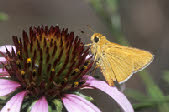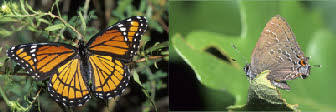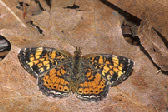The Butterflies of the World Foundation
A Non-





Sachem
Atalopedes campestris, Boisduval, 1852
Subfamily Hesperiinae
Tribe Hesperiini
Taxonomy
The family Hesperiidae includes all butterflies that are collectively called skippers because of their fast skipping flight. This family is the sole member of the Superfamily Hesperioidea. Whereas, the other five families of butterflies belong to the Superfamily Papilionoidea. So, skippers are considered butterflies, but they have a few traits different than the species of “True” butterflies found in the Superfamily Papilionoidea. Some of these traits include large eyes, short antennae (often with hooked clubs) and stout bodies. Most also have a very rapid flight with a fast, almost blurred, wing beat. There are about 3,500 species of skippers and they’re further divided into seven subfamilies. They occur worldwide with more found in the tropics. Most species are brown or tan, but some tropical members can be quite colorful.

Atalopedes campestris, captured by Jagged Ambush Bug, Phymata sp., Lexington Wildlife Management Area, Cleveland County, Oklahoma, 12 August 2008
Ref #: I-
All photographs, artwork, text and website design are the property of The Butterflies of the World Foundation (unless otherwise stated) and are protected under national and international copyright laws. Photographs, artwork or text on this website may not be reproduced in any way without prior written consent of The Butterflies of the World Foundation.

Atalopedes campestris, Lexington Wildlife Management Area, Cleveland County, Oklahoma,
5 August 2010 Ref #:
I-

Atalopedes campestris, captured by Jagged Ambush Bug, Phymata sp., Lexington Wildlife
Management Area, Cleveland County, Oklahoma, 12 August 2008 Ref #: I-
Atalopedes campestris, Lexington Wildlife Management Area, Cleveland County, Oklahoma,
21 September 2005 Ref #:
I-

Atalopedes campestris, Lexington Wildlife Management Area, Cleveland County, Oklahoma,
22 September 2005 Ref #: I-

Atalopedes campestris, Lexington Wildlife Management Area, Cleveland County, Oklahoma,
11 July 2009 Ref
#: I-

Atalopedes campestris, Thunderbird Lake State Park, Cleveland County, Oklahoma, 26
June 2005 Ref
#: I-

Atalopedes campestris, Lexington Wildlife Management Area, Cleveland County, Oklahoma,
21 September 2005 Ref #:
I-

Atalopedes campestris, Lexington Wildlife Management Area, Cleveland County, Oklahoma,
22 September 2005 Ref #: I-

Atalopedes campestris, Lexington Wildlife Management Area, Cleveland County, Oklahoma,
23 September 2005 Ref #:
I-

Atalopedes campestris, Lexington Wildlife Management Area, Cleveland County, Oklahoma,
12 August 2008 Ref #:
I-

Atalopedes campestris, Lexington Wildlife Management Area, Cleveland County, Oklahoma,
21 September 2005 Ref #:
I-

Atalopedes campestris, Lexington Wildlife Management Area, Cleveland County, Oklahoma,
21 September 2005 Ref #: I-

Atalopedes campestris, Lexington Wildlife Management Area, Cleveland County, Oklahoma,
11 July 2009 Ref #:
I-

Atalopedes campestris, Lexington Wildlife Management Area, Cleveland County, Oklahoma,
8 October 2005 Ref
#: I-

Atalopedes campestris, Tallgrass Prairie Preserve, Osage County, Oklahoma, 26 June
2010 Ref
#: I-

Atalopedes campestris, Ouachita National Forest, Beech Creek, Le Flore County, Oklahoma,
28 June 2010 Ref #:
I-

Atalopedes campestris, Ouachita National Forest, Beech Creek, Le Flore County, Oklahoma,
28 June 2010 Ref
#: I-

Atalopedes campestris, Ouachita National Forest, Beech Creek, Le Flore County, Oklahoma,
28 June 2010 Ref #:
I-

Atalopedes campestris, Lexington Wildlife Management Area, Cleveland County, Oklahoma,
5 August 2010 Ref #:
I-

Atalopedes campestris, courting pair, Sulphur, Murray County, Oklahoma, 19 April 2011
Ref
#: I-

Atalopedes campestris, Pontotoc Ridge Preserve, Pontotoc County, Oklahoma, 11 June
2011 Ref
#: I-
General Information:
Atalopedes campestris belongs to the subfamily Hesperiinae. This species is found from the southern United States from Virginia west to California then south through Mexico and Central America to Brazil. It strays and colonizes north to central North Dakota, southern Michigan, Manitoba and northern Pennsylvania. It preferred habitat includes disturbed, open areas such as roadsides, landfills, pastures, meadows, fencerows, yards, parks and lawns. It can be very common in lawns and is sometimes referred as the “little orange moth” by home owners. It shares that distinction with the Fiery Skipper, Hylephila phyleus.
Lifecycle:
The larval food source includes various grasses such as Bermuda grass, Cynodon dactylon, crabgrass, Digitaria sp., St. Augustine grass, Stenotaphrum secundatum, and goosegrass, Eleusine sp. Males perch on or near the ground during most of the day to wait for receptive females. Females lay single eggs on dry grass blades in the afternoon. Caterpillars feed on leaves and live at the base of grasses in shelters of rolled or tied leaves.

Atalopedes campestris, Lexington Wildlife Management Area, Cleveland County, Oklahoma,
26 September 2005 Ref #: I-

Atalopedes campestris, Lexington Wildlife Management Area, Cleveland County, Oklahoma,
22 September 2005 Ref #: I-

Atalopedes campestris, Lexington Wildlife Management Area, Cleveland County, Oklahoma,
14 May 2009 Ref
#: I-

Atalopedes campestris, Lexington Wildlife Management Area, Cleveland County, Oklahoma,
22 September 2005 Ref #: I-

Atalopedes campestris, Lexington Wildlife Management Area, Cleveland County, Oklahoma,
22 September 2005 Ref #:
I-

Atalopedes campestris, Pontotoc Ridge Preserve, Pontotoc County, Oklahoma, 18 April
2012 Ref
#: I-